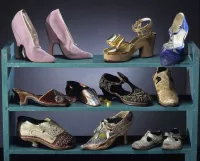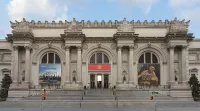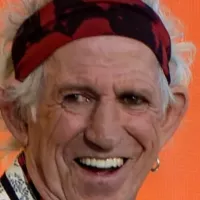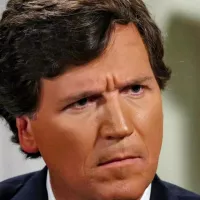Chanel is a French luxury fashion house established in 1910 by Coco Chanel in Paris. This privately held company, owned by the Wertheimer brothers, operates under Chanel Limited, which is headquartered in London. Known for its haute couture, ready-to-wear clothes, handbags, perfumes, and cosmetics, Chanel has become a globally recognized symbol of high fashion and timeless elegance.
1901: British Edwardian era began
Around 1901–1919, during the British Edwardian era, hourglass figure fashions contrast with Chanel's later simple-line designs.
1909: Gabrielle Chanel opened a millinery shop
In 1909, Gabrielle Chanel opened a millinery shop at 160 Boulevard Malesherbes, Paris, within Étienne Balsan's flat, providing her with exposure to wealthy clientele.
1910: Boy Capel financed Chanel Modes
In 1910, Boy Capel financed Coco Chanel's first independent millinery shop, Chanel Modes, at 31 Rue Cambon in Paris. The location restricted her to selling only millinery due to an existing dress shop.
1910: Coco Chanel founded the luxury fashion house in Paris
In 1910, Coco Chanel founded the Chanel luxury fashion house in Paris.
1912: The signature shape featured a below-mid-calf-length
In 1912, the signature shape featured a below-mid-calf-length, full-skirt, a narrow waist, and a large bust (stylistically absent since 1912).
1913: Deauville and Biarritz couture shops offered prêt-à-porter sports clothes
In 1913, Coco Chanel's Deauville and Biarritz couture shops began offering prêt-à-porter sports clothes for women, designed for practicality in sports.
1914: The First World War affected European fashion
The First World War (1914-1918) affected European fashion through scarcity of materials and the mobilization of women.
1915: La Maison Chanel garments were "on the list of every buyer"
In 1915, Harper's Bazaar magazine reported that the garments of La Maison Chanel were "on the list of every buyer" for the clothing factories of Europe.
1917: Harper's Bazaar reported La Maison Chanel garments were in demand
In 1917, Harper's Bazaar magazine reported that La Maison Chanel garments were "on the list of every buyer" for clothing factories in Europe, highlighting the popularity of day-wear ensembles and black evening dresses.
1918: The First World War affected European fashion
The First World War (1914-1918) affected European fashion through scarcity of materials and the mobilization of women.
1919: British Edwardian era ended
Around 1901–1919, during the British Edwardian era, hourglass figure fashions contrast with Chanel's later simple-line designs.
January 1921: First Use and Commercial Use of No. 5 Perfume
The first use and commercial use of the No. 5 Perfume started on January 1921.
1921: Coco Chanel commissioned Ernest Beaux to create a perfume
In 1921, Coco Chanel commissioned perfumer Ernest Beaux to create a perfume for La Maison Chanel, leading to the creation of the iconic perfume No.5.
1922: La Maison Chanel offered perfume No.5 for sale
In 1922, La Maison Chanel began offering perfume No.5 for sale to the public, due to its popularity as a gift to clients.
1923: Coco Chanel stated that "simplicity is the keynote of all true elegance"
In 1923, Coco Chanel told Harper's Bazaar magazine that design "simplicity is the keynote of all true elegance," explaining the success of her clothes.
November 1924: Trademark Applications Filed
On Tuesday, November 1924, Chanel, Inc. filed trademark applications for the typeset mark Chanel and for the interlocking CC design plus word mark, for perfume, toiletry, and cosmetic products.
1924: Coco Chanel renegotiated her partnership with Parfums Chanel
In 1924, Coco Chanel attempted to renegotiate her 10% partnership with Parfums Chanel, but the lawyer-to-lawyer negotiations failed and the original business deal with Wertheimer and Badel remained unchanged.
1924: Founding of Parfums Chanel
In 1924, Pierre Wertheimer founded Parfums Chanel to produce and sell perfumes and cosmetics, becoming the most profitable division of Chanel S.A.
1924: Pierre Wertheimer renegotiated the contract with Chanel
In May 1947, Pierre Wertheimer renegotiated the 1924 contract with Coco Chanel, paying her $400,000, assigning a 2.0% royalty from No. 5 sales, granting limited commercial rights in Switzerland, and providing a monthly stipend in exchange for closing her Swiss parfumerie and selling full rights to the name "Coco Chanel".
February 1925: Chanel and Double-C Trademarks Awarded
On February 1925, The Chanel and double-C trademarks were awarded to Chanel, Inc.
April 1926: No. 5 Perfume Trademark Application
On Thursday, April 1926, the first trademark application for the No. 5 perfume was filed, described as perfume and toilet water.
July 1926: Registration Granted for No. 5 Perfume Trademark
On July 1926, registration was granted for the No. 5 Perfume Trademark.
November 1932: Debut of 'Bijoux de Diamants' Collection
In November 1932, Chanel 'High Jewellery' was founded and debuted the 'Bijoux de Diamants' collection, the first high-end jewelry collection by a fashion designer, inspired by celestial forms.
1932: Chanel presented an exhibition of jewellery dedicated to the diamond
In 1932, Chanel presented an exhibition of jewellery dedicated to the diamond as a fashion accessory, featuring the Comet and Fountain necklaces of diamonds.
1937: The House of Chanel expanded to design clothes for petite women
By 1937, the House of Chanel had expanded the range of its clothes and presented prêt-à-porter clothes designed and cut for the petite woman.
May 1940: Pierre Wertheimer designated Felix Amiot as the "Aryan" proxy
In May 1940, Pierre Wertheimer, anticipating Nazi occupation policies, designated Felix Amiot, a Christian French industrialist, as the "Aryan" proxy to legally control Parfums Chanel.
June 1940: Nazis established a Parisian occupation-headquarters
In June 1940, after conquering France, the Nazis established their Parisian occupation headquarters at the Hôtel Meurice, near the Maison Chanel.
1941: Coco Chanel attempted to assume business control of Parfums Chanel
In 1941, Coco Chanel attempted to assume business control of Parfums Chanel but was blocked by an administrative delegation.
September 1944: Chanel was interrogated for collaboration with the Nazis
In September 1944, Coco Chanel was summoned for interrogation by the Free French Purge Committee, épuration, regarding her collaboration with the Nazis.
May 1947: Pierre Wertheimer renegotiated the contract with Chanel
In May 1947, Pierre Wertheimer renegotiated the 1924 contract with Coco Chanel, paying her $400,000, assigning a 2.0% royalty from No. 5 sales, granting limited commercial rights in Switzerland, and providing a monthly stipend in exchange for closing her Swiss parfumerie and selling full rights to the name "Coco Chanel".
1947: Coco Chanel found the fashion business enamoured of the "New Look"
In 1953, upon returning to France from Switzerland, Coco Chanel found the fashion business enamoured of the "New Look" (1947) by Christian Dior.
1953: Chanel collaborated with jeweler Robert Goossens
In 1953, Chanel collaborated with jeweler Robert Goossens to design jewelry to complement Chanel's fashions, including long-strand necklaces of black and white pearls.
1953: Coco Chanel found the fashion business enamoured of the "New Look"
In 1953, upon returning to France from Switzerland, Coco Chanel found the fashion business enamoured of the "New Look" (1947) by Christian Dior.
February 1955: The quilted-leather handbag was presented to the public
In February 1955, the quilted-leather handbag was presented to the public. The internal designation for that model of handbag became "Chanel 2.55".
1955: Introduction of the Chanel 2.55 Handbag
In 1955, the Chanel 2.55 handbag was introduced, revolutionizing women's fashion with its shoulder strap for hands-free use.
1956: One of Pierre Wertheimer's horses won the English Derby
In 1956, one of Pierre Wertheimer's horses won the English Derby, after which Coco Chanel refused to kiss him due to her resentment.
1957: Chanel received the Fashion Oscar at the Fashion Awards in Dallas
In 1957, Chanel and her spring collection received the Fashion Oscar at the Fashion Awards in Dallas. Pierre Wertheimer also increased his stake in Parfums Chanel.
1965: Jacques Wertheimer assumed management of the parfumerie
In 1965, Jacques Wertheimer, Pierre's son, took over his father's management of the parfumerie.
1966: Coco Chanel designed the air hostess uniforms for Olympic Airways
In the (1966–1969) period, Coco Chanel designed the air hostess uniforms for Olympic Airways.
1969: Coco Chanel designed the air hostess uniforms for Olympic Airways
In the (1966–1969) period, Coco Chanel designed the air hostess uniforms for Olympic Airways.
January 1971: Coco Chanel died at the age of 87
Coco Chanel died on January 10, 1971, at the age of 87. She was still designing at the time of her death.
1974: Alain Wertheimer Assumes Control
In 1974, Alain Wertheimer, Jacques Wertheimer's son, took over Chanel S.A.
1974: The House of Chanel launched Cristalle eau de toilette
In 1974, the House of Chanel launched Cristalle eau de toilette, which was designed when Coco Chanel was alive.
1978: Launch of the first prêt-à-porter line and worldwide distribution of accessories
1978 saw the launch of the first non-couture, prêt-à-porter line and worldwide distribution of accessories.
1981: Antaeus Launch
In 1981, Chanel launched Antaeus, an eau de toilette for men.
1983: Karl Lagerfeld Appointed Chief Designer
In 1983, Karl Lagerfeld became Chanel's chief designer, incorporating signature Chanel elements while also modernizing the brand.
1983: Introduction of the 11.12 Handbag
In 1983, Karl Lagerfeld introduced the 11.12 handbag, featuring the iconic double-C logo.
1984: Coco Fragrance Launch
In 1984, Chanel launched a new fragrance in honor of the founder, Coco.
1986: Deal with Watchmakers
In 1986, the House of Chanel made a deal with watchmakers to produce Chanel branded watches.
1987: Chanel wristwatch division established
In 1987, the Chanel wristwatch division was established.
1987: First Chanel Watch Debut
In 1987, the first Chanel watch was released.
1993: Chanel S.A. re-presented the Comet and Fountain necklaces
In 1993, Chanel S.A. re-presented the Comet and Fountain necklaces of diamonds, which were originally designed in 1932.
1994: Profitability Milestone
In 1994, Chanel achieved a net profit of €67 million on €570 million in ready-to-wear clothes sales, becoming the most profitable French fashion house.
1995: Presentation of the Matelassé wristwatch
In 1995, Chanel's wristwatch division presented the Matelassé, its second wristwatch design.
1996: Acquisition of Holland & Holland and Eres, and Allure perfume launch
In 1996, Chanel acquired gun-makers Holland & Holland and swimwear label Eres, and launched the perfumes Allure.
1997: Establishment of Paraffection subsidiary
In 1997, Chanel established Paraffection, a subsidiary company to support artisanal manufacturing, gathering together Ateliers d'Art or workshops.
1998: Allure Homme Launch
In 1998, Chanel launched the fragrance Allure Homme.
1999: Précision Skincare and Travel Collection Launch
In 1999, Chanel launched its first skin care line, Précision, and a travel collection, along with a line of sunglasses and eyeglass frames under license with Luxottica.
2000: Launch of the J12 Unisex Watch
In 2000, Chanel launched its first unisex watch, the J12.
2000: Presentation of the Chanel J12 wristwatch line
In 2000, Chanel presented the Chanel J12 line of unisex style wristwatches, made of ceramic materials, establishing Chanel wristwatches as a Chanel marque.
2001: Acquisition of Bell & Ross and Boutique Expansion
In 2001, Chanel acquired watchmaker Bell & Ross and opened accessory-only boutiques in the United States, also introducing a small menswear collection.
July 2002: Jewelry and Watch Outlet Opening
In July 2002, Chanel opened a jewelry and watch outlet on Madison Avenue.
December 2002: Boutique Expansion in the U.S.
By December 2002, Chanel operated 25 U.S. boutiques, including a new shoe/handbag boutique on Madison Avenue.
2002: Launch of Chance perfume and Paraffection subsidiary
In 2002, Chanel launched the Chance perfume and consolidated artisanal workshops under the Paraffection subsidiary. Karl Lagerfeld designed a prêt-à-porter collection.
2005: Coco Chanel Exhibit at The Metropolitan Museum of Art
In 2005, The Metropolitan Museum of Art held an exhibit chronicling Coco Chanel's designs dating back to the 1920s.
2007: Maureen Chiquet Appointed CEO
In 2007, Maureen Chiquet was appointed as the CEO of Chanel.
2008: Development of the ceramic Chanel AP-3125 clockwork
In 2008, Chanel S.A. and Audemars Piguet developed the ceramic Chanel AP-3125 clockwork, exclusive to the House of Chanel.
2011: Fondation Chanel Founded
In 2011, Fondation Chanel, the philanthropic arm of the house, was founded to promote healthcare advocacy, address gender-based violence, and accelerate economic agency and empowerment.
2012: 80th Anniversary of 'Bijoux de Diamants'
In 2012, Chanel created a special collection to celebrate the 80th anniversary of 'Bijoux de Diamants'.
2015: Purchase of Retail Space on Rodeo Drive
In 2015, Chanel paid a record $152 million for retail space on 400 North Rodeo Drive in Beverly Hills.
2016: Maureen Chiquet's Termination as CEO
In 2016, Maureen Chiquet was terminated from her position as CEO of Chanel.
2018: Chanel Limited established in London
In 2018, Alain and Gérard Wertheimer established Chanel Limited, the holding company, headquartered in London.
2018: Chanel acquired Orlebar Brown
In 2018, Chanel acquired clothing brand Orlebar Brown, a brand specializing in tailored men's swim shorts.
2018: Headquarters Relocation and Fur Ban
In 2018, Chanel announced the relocation of its global headquarters to London and banned fur and exotic skins from its collections.
2018: Lawsuit Against The RealReal
In 2018, Chanel filed a lawsuit against The RealReal, alleging the sale of counterfeit Chanel products and implying an affiliation between the two companies.
February 2019: Death of Karl Lagerfeld and Appointment of Virginie Viard
In February 2019, Karl Lagerfeld passed away, and Virginie Viard was named the new Creative Director of Chanel.
October 1, 2020: Gabrielle Chanel Exhibition at Palais Galliera
On October 1, 2020, the Palais Galliera featured a retrospective, Gabrielle Chanel. Fashion Manifesto.
October 2020: Purchase of Bond Street Boutique
In October 2020, Chanel bought its flagship Bond Street boutique in London for £310 million.
June 2021: Investment in Landscape Resilience Fund
In June 2021, Chanel announced an anchor investment in the Landscape Resilience Fund, contributing $25 million to farmers facing climate change impacts.
August 17, 2021: End of Gabrielle Chanel Exhibition at Palais Galliera
On August 17, 2021, the Gabrielle Chanel. Fashion Manifesto exhibition concluded at Palais Galliera.
December 3, 2021: Gabrielle Chanel Exhibition at Mitsubishi Ichigokan Museum
On December 3, 2021, the Gabrielle Chanel. Fashion Manifesto exhibition opened at Mitsubishi Ichigokan Museum in Tokyo.
December 2021: Leena Nair Appointed Global CEO
In December 2021, Leena Nair was appointed as the Global Chief Executive Officer of Chanel.
April 25, 2022: End of Gabrielle Chanel Exhibition at Mitsubishi Ichigokan Museum
On April 25, 2022, the Gabrielle Chanel. Fashion Manifesto exhibition concluded at Mitsubishi Ichigokan Museum in Tokyo.
October 11, 2022: Picasso-Chanel Exhibition at ThyssenBornemisza National Museum
On October 11, 2022, the ThyssenBornemisza National Museum in Madrid opened an exhibition exploring the relationship between Pablo Picasso and Gabrielle Chanel.
2022: Donation to Ukraine
In 2022, Chanel donated €2 million to Care and UNHCR to support Ukraine during the Russian invasion.
2022: No.1 de Chanel Launch
In 2022, Chanel launched the No.1 de Chanel beauty and fragrance line, featuring 97% naturally derived ingredients and eco-conscious packaging.
January 15, 2023: End of Picasso-Chanel Exhibition at ThyssenBornemisza National Museum
On January 15, 2023, the exhibition exploring the relationship between Pablo Picasso and Gabrielle Chanel concluded at the ThyssenBornemisza National Museum in Madrid.
September 16, 2023: Gabrielle Chanel Exhibition at Victoria & Albert Museum
On September 16, 2023, the Gabrielle Chanel. Fashion Manifesto exhibition debuted at London's Victoria & Albert Museum.
January 2024: Traceability Alliance for Sustainable Cosmetics
In January 2024, Chanel launched an initiative with a consortium of 15 cosmetics manufacturers, called the Traceability Alliance for Sustainable Cosmetics to catalyze traceability in the cosmetics sector.
February 2024: U.S. Flagship Store Opening
In February 2024, Chanel opened its U.S. flagship store dedicated to watches and fine jewelry on Fifth Avenue in Midtown Manhattan, New York City.
June 2024: Departure of Virginie Viard
In June 2024, Virginie Viard departed from the brand Chanel.
December 2024: Matthieu Blazy Appointed Artistic Director
In December 2024, Matthieu Blazy was appointed as the next Artistic Director of Chanel.
2024: Chanel stake in MB&F, F. P. Journe and Romain Gauthier
As of 2024, Chanel holds a 25% stake in MB&F, 20% in F. P. Journe and an undisclosed stake in Romain Gauthier.
2025: Transition to 100% Renewable Electricity
Chanel pledged to transition to 100% renewable electricity by 2025 as part of the Chanel Mission 1.5 Climate Action Plan.
2030: Carbon Footprint Reduction Goals
Chanel set goals to reduce its carbon footprint by 50% and emissions from its value chain by 40% by 2030.
Mentioned in this timeline
Ukraine is a large country in Eastern Europe second in...
The United States of America is a federal republic located...
Hong Kong is a Special Administrative Region of the People's...

A shoe is a protective and comfort-providing item of footwear...

Los Angeles is the most populous city in California and...

The Metropolitan Museum of Art or the Met is a...
Trending

7 months ago Matt Rife Announces Birmingham Comedy Tour Stop and Stars in New Rom-Com!

1 month ago Government Shutdown: Americans Scrambling, Washington's Economy Hit, and Tourism Suffers in D.C.
6 months ago KeyBank Foundation Backs Affordable, Sustainable Housing and Healthy Homes Initiative.

5 months ago Bianca Censori's Past Modeling, Raunchy PDA with Kanye, and Future Plans Spark Debate.

1 month ago Alex Bregman Enters Free Agency; Red Sox Interested, Projected $160M Deal?

Keith Richards is a renowned English musician songwriter singer and record producer best known as a founding member guitarist and...
Popular

Candace Owens is an American conservative political commentator and author...

Ilhan Omar is an American politician currently serving as the...

XXXTentacion born Jahseh Dwayne Ricardo Onfroy was a controversial yet...

Tucker Carlson is an American conservative political commentator known for...

Charles James Charlie Kirk was a prominent American right-wing political...

Kashyap Pramod Patel is an American lawyer who became the...